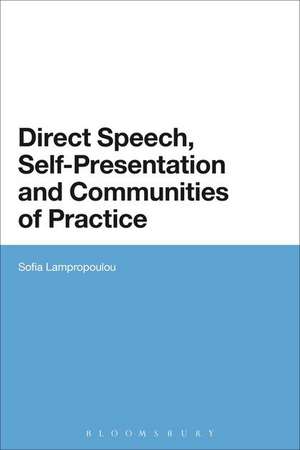Direct Speech, Self-presentation and Communities of Practice
Autor Dr Sofia Lampropoulouen Limba Engleză Paperback – 6 noi 2013
| Toate formatele și edițiile | Preț | Express |
|---|---|---|
| Paperback (1) | 256.59 lei 6-8 săpt. | |
| Bloomsbury Publishing – 6 noi 2013 | 256.59 lei 6-8 săpt. | |
| Hardback (1) | 1006.79 lei 6-8 săpt. | |
| Bloomsbury Publishing – 25 apr 2012 | 1006.79 lei 6-8 săpt. |
Preț: 256.59 lei
Preț vechi: 294.91 lei
-13% Nou
Puncte Express: 385
Preț estimativ în valută:
49.10€ • 51.41$ • 40.72£
49.10€ • 51.41$ • 40.72£
Carte tipărită la comandă
Livrare economică 09-23 aprilie
Preluare comenzi: 021 569.72.76
Specificații
ISBN-13: 9781472534781
ISBN-10: 1472534786
Pagini: 224
Dimensiuni: 156 x 234 x 12 mm
Greutate: 0.32 kg
Editura: Bloomsbury Publishing
Colecția Bloomsbury Academic
Locul publicării:London, United Kingdom
ISBN-10: 1472534786
Pagini: 224
Dimensiuni: 156 x 234 x 12 mm
Greutate: 0.32 kg
Editura: Bloomsbury Publishing
Colecția Bloomsbury Academic
Locul publicării:London, United Kingdom
Caracteristici
Is both quantitative and qualitative in its analysis of direct speech in spoken discourse.
Notă biografică
Sofia Lampropoulou is Lecturer in English Language at University of Liverpool, UK
Cuprins
Acknowledgements List of tables List of abbreviations Transcription conventions Introduction Chapter 1: Speech Representation and Direct Speech Chapter 2: Narrative and Self-presentation Chapter 3: Data and Methods Chapter 4: Distributions, Frequencies and Factors Affecting Direct Speech Variation Chapter 5: Voice Representation, Gender and Dominant Discourses Chapter 6: Self-presentation Chapter 7: Self through Other-presentation Overview and Conclusions Appendix References Index
Recenzii
Sofia Lampropoulou's beautifully-exemplified Direct Speech, Self-presentation and Communities of Practice makes interesting contributions to the fields of narrative, the nature of talk, and the construction of gender. Commendably clear in its methodology, it also constitutes an excellent example of contemporary empirical research in linguistics.
In this thorough exploration of the richness and complexity of speech representation in everyday storytelling Sofia Lampropoulou demonstrates the power of narrative analysis in the investigation of identities as emergent in social practices.
Sofia Lampropoulou's in-depth study of (direct) speech representation in Greek adolescents' naturally occurring stories makes an original contribution to our understanding of the fascinating relationship between representation through discourse -- including self-presentation and positioning in groups and communities -- and social identities. A valuable resource for scholars with an interest in the linguistic analysis of narratives, communities of practice, and the construction of identity in talk.
[T]he book probes and explores new and relevant aspects of interactive storytelling, provides input to the field of narratology through the analysis of direct speech, and illustrates how the complexity and diversity of speech representation is relevant in both the local and socio-cultural context in which it is embedded. The book surely lends a new dimension to Discourse Studies readers interested in interactive storytelling analyses.
In this thorough exploration of the richness and complexity of speech representation in everyday storytelling Sofia Lampropoulou demonstrates the power of narrative analysis in the investigation of identities as emergent in social practices.
Sofia Lampropoulou's in-depth study of (direct) speech representation in Greek adolescents' naturally occurring stories makes an original contribution to our understanding of the fascinating relationship between representation through discourse -- including self-presentation and positioning in groups and communities -- and social identities. A valuable resource for scholars with an interest in the linguistic analysis of narratives, communities of practice, and the construction of identity in talk.
[T]he book probes and explores new and relevant aspects of interactive storytelling, provides input to the field of narratology through the analysis of direct speech, and illustrates how the complexity and diversity of speech representation is relevant in both the local and socio-cultural context in which it is embedded. The book surely lends a new dimension to Discourse Studies readers interested in interactive storytelling analyses.
Descriere
Descriere de la o altă ediție sau format:
Offers an analysis of speech representation and social identity in narrative. This book investigates direct speech representation in Greek adolescents' storytelling. It examines how narrators present themselves and other characters as interactional protagonists through representational strategies in the stories they produce.
Offers an analysis of speech representation and social identity in narrative. This book investigates direct speech representation in Greek adolescents' storytelling. It examines how narrators present themselves and other characters as interactional protagonists through representational strategies in the stories they produce.













